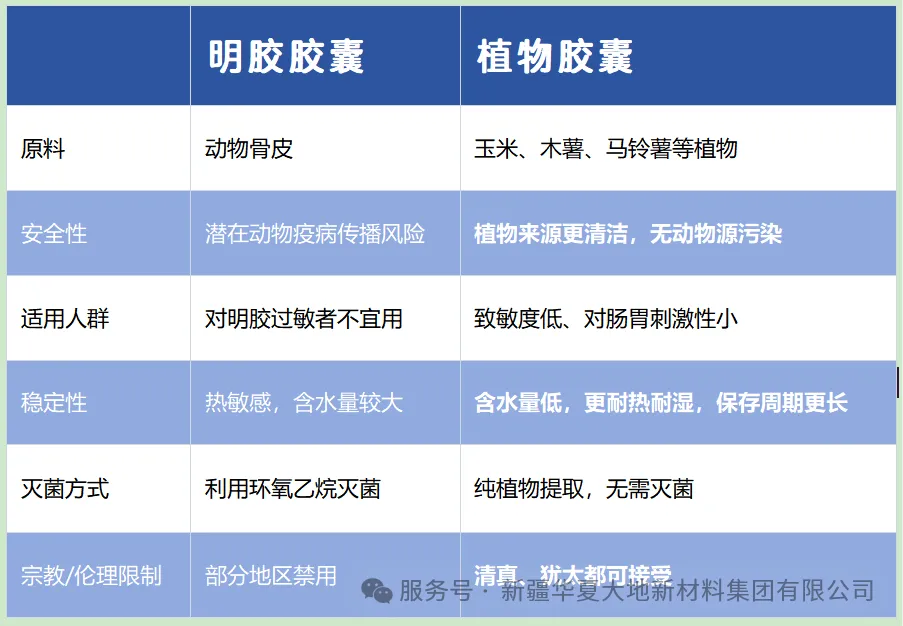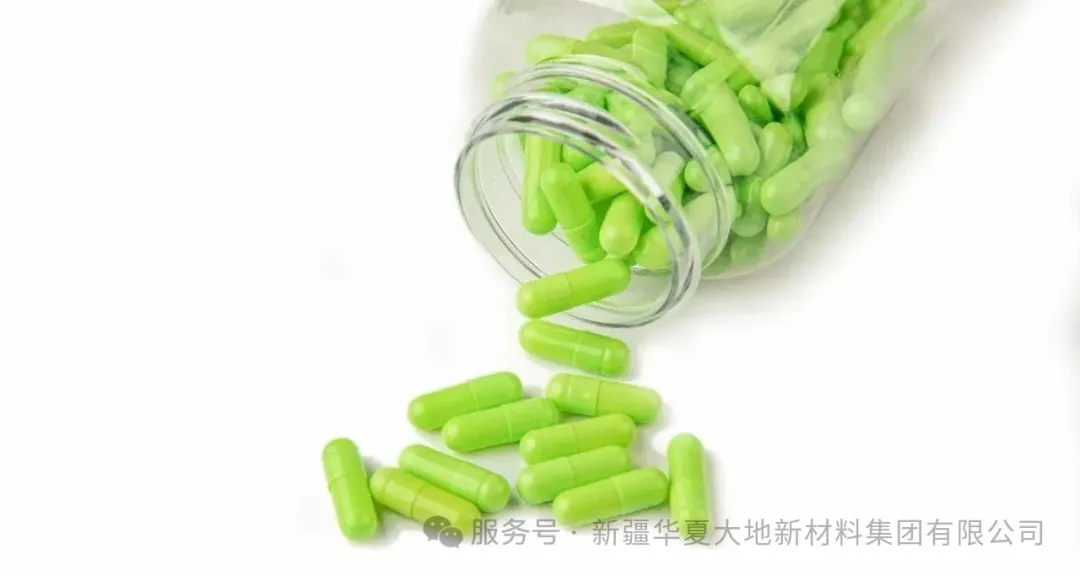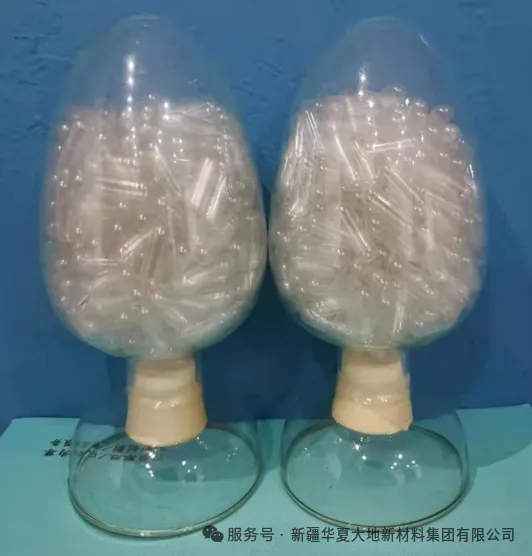Corn-based pure plant capsule shell
In the field of medicine and health, the safety and functionality of capsule shells are of utmost importance. Traditional gelatin capsule shells have inherent risks, while our newly developed corn-based pure plant-based capsule shells, with corn polysaccharides as the core raw material, have achieved breakthroughs through cutting-edge technology, bringing a brand-new solution to the pharmaceutical industry!
How much do you know about the capsule shells that you swallow when taking medicine?
Do you know? When taking medicine, the capsule shells that we swallow together are not just simple "packaging". Their material is related to health, efficacy, and even has connections with religious ethics. Today, let's talk about the secrets hidden within these small capsule shells, as well as the exploration of the Xinjiang Huaxia Land New Materials Group in the innovation of capsule shells.

Gelatin and Plant Capsules: What Are the Differences?
Capsule shell material: Differences between gelatin and plant-based sources
Medicinal capsule shells serve as the "protective cover" for drugs, preventing them from being prematurely damaged by stomach acid and making them easier to swallow. However, there are significant differences among various types of capsule shells.
(1) Traditional gelatin capsule shells
Traditional gelatin capsules are mainly made from the bones and skins of animals such as cows and pigs. Although they have been in use for many years, they carry hidden risks. For instance, the toxic gelatin incident that occurred in the past has raised doubts about their safety. Moreover, since the raw materials come from animals, they may conflict with some religious beliefs (such as the Islamic religion's prohibition against animal products), which limits their market expansion.
(2) Plant-based capsule shells
Plant-based capsule shells are made from plants, such as corn and seaweed, as sources. They are safe and controllable, with a traceable production process, ensuring the quality of each capsule shell. There are no religious or ethical controversies. They are more suitable for the global market. They are also more friendly to people with sensitive stomachs, the elderly, and children. At the same time, with the help of new materials (such as HPMC, seaweed polysaccharides, etc.), plant-based capsule shells can have stronger functionality, conforming to the green environmental trend, and receiving policy support. This is a new direction for the development of capsule shells.

Why are plant capsules becoming increasingly popular?
Safe and controllable: 100% derived from plants, with a traceable production process, ensuring the quality of each capsule.
Global Adaptation: Widely adopted by multinational pharmaceutical companies and health supplement companies, it meets the global market demand.
Suitable for sensitive individuals: Such as those with weak digestive systems, children and the elderly, etc. Plant capsules are a safer option.
Technology-driven: New materials (such as HPMC, seaweed polysaccharides, and potato starch) endow plant capsules with enhanced functionality.
Sustainable development: In line with the green environmental protection trend and with strong policy support.

In today's era where "carbon peak" and "carbon neutrality" have become buzzwords, all industries are accelerating their green transformation. You might not have expected this - even a tiny capsule shell contains a huge "carbon footprint".
Traditional capsules are mostly made from animal gelatin, which involves high energy consumption and high emissions. However, nowadays, an eco-friendly capsule derived from plants is quietly rewriting the "carbon bill" of the pharmaceutical industry. It is not only an upgrade of the excipients, but also the future engine of green medicine.
Traditional gelatin capsules are made from the bones of cattle and pigs, which result in high methane emissions from the livestock industry and a significant carbon footprint. On the other hand, plant capsules typically use plant starch (such as cassava, corn, and potatoes) and hydroxypropyl methylcellulose as their main raw materials. The planting process has low carbon emissions, effectively reducing carbon at the source.
In terms of production, the gelatin capsule process is energy-intensive. However, the plant capsule process is more gentle and efficient, and is better suited for integrating with renewable energy sources. In the logistics aspect, plant capsules have a lower density and less moisture content, resulting in higher transportation and loading efficiency, thereby further reducing carbon emissions per unit.
One capsule - how much carbon can it save?
Measured in terms of millions of units, the carbon reduction potential of plant capsules is significantly superior to that of traditional gelatin capsules. When this innovation is scaled up to a global pharmaceutical scale, the cumulative reduction contribution will be extremely significant!
Just like choosing to ride a bike instead of driving a car, a small green change, multiplied by billions of applications, is sufficient to bring about a massive climate action.
Our Xinjiang Huaxia Dadi New Materials Group focuses on the research and development of plant-based pharmaceutical excipients. We have launched a corn-based pure plant-based capsule shell, using innovative technologies to add new strength to the medical and health sector.
Project Introduction
Technological breakthroughs ensure quality.
By adopting cutting-edge technologies such as instantaneous ultra-high temperature modification, microwave-assisted film formation, and variable-temperature vacuum rapid curing, the effective components like polysaccharides extracted from corn are used to produce capsule shells. The resulting capsule shells have stable physical properties, excelling in aspects such as hardness, toughness, and disintegration time. They can meet the strict requirements of drugs and health supplements for carriers, and also possess health-preserving and health-promoting functions, thereby adding more value to the capsule shells.
Safety upgrade, eliminating potential risks
Unlike traditional gelatin capsules (which are mostly made from animal skins and carry the risk of toxic gelatin), our corn-based pure plant-based capsule shells are 100% derived from plants. This fundamentally eliminates the risk of toxic gelatin, making each capsule shell a reliable "little guardian" for maintaining health.
A vast market with unlimited potential
Traditional capsule shells are incompatible with the religious beliefs of some Islamic countries due to raw material issues. However, our corn-based pure plant-based capsule shells perfectly meet the demands of regions such as Central Asia, West Asia, Southeast Asia, and North Africa. They are expected to reshape the international capsule shell market landscape. With its pure plant nature and outstanding performance, it can compete with similar products, helping enterprises seize a wide market share and opening up new business opportunities for the pharmaceutical and health industry.

The future of plant capsule shells, driven by the combined demands for safety, environmental protection and technology, is no longer merely a "substitute" for traditional gelatin capsule shells. Instead, they are gradually becoming the mainstream choice in the pharmaceutical industry. Xinjiang Huaxia Dadi New Materials Group will continue to deeply engage in the technological research and production of corn-based pure plant-type capsule shells, optimize product performance, expand production capacity, and use green, safe and high-quality products to inject new vitality into the global pharmaceutical and health industry.



